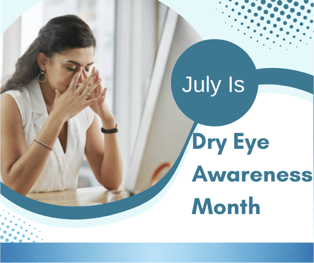Home » Blog » July is National Dry Eye Awareness Month
July is National Dry Eye Awareness Month
Posted by: Mitchell Refractive Surgery & Eye Center

July is National Dry Eye Awareness Month. Dry eye disease is a multifactorial disease that affects an estimated 25 million people in the United States. It is often a condition that is under-recognized and under-diagnosed. We want to empower you with information that may help you or your loved one.
According to the American Academy of Ophthalmology, dry eye is a condition in which a person does not have enough quality tears to lubricate and nourish the eye. Tears are necessary to maintain the eye’s front surface’s health and provide clear vision.
Did you know that dry eye is common and often a chronic problem, particularly in older adults? An article published in the Journal of Global Health reported that studies have shown the prevalence of dry eye ranges from 5 percent to as high as 50 percent in different populations worldwide. In the United States, a study by Market Scope estimates that 17.2 million were diagnosed with dry eye in 2019.
Dry Eye Symptoms
Here are a few symptoms of dry eye:
- Feeling like something is in your eye (foreign body sensation)
- Red eyes
- Itchy eyes
- Fatigued eyes
- Burning sensation
- Photophobia (Light Sensitivity)
- Discomfort when wearing contact lenses
- Aching sensation
What Causes Dry Eyes?
There are many potential origins of dry eyes. Here are a few of the most common causes.
- Aging – Dry eye can occur at any age, but it becomes more common as you age, especially after age 50.
- Computer use – Working at a computer or a digital device, we tend to blink our eyes less thoroughly and less frequently. Excessive computer use leads to greater tear evaporation and an increased risk of dry eye symptoms.
- Menopause – Post-menopausal women are at risk of dry eyes more than men of the same age.
- Wearing a mask – A mask to protect against the spread of a virus may cause dry eye by forcing air out the top of the mask and over the eye’s surface.
- Medications – Many medicines increase the risk of dry eye symptoms, including antidepressants, antihistamines, blood pressure medications, and birth control pills.
- Indoor environment – Air conditioning and ceiling fans can decrease indoor humidity. This type of environment can accelerate tear evaporation, causing dry eye symptoms.
- Health conditions – Certain diseases such as rheumatoid arthritis, diabetes, thyroid-associated conditions, and lupus can contribute to dry eye problems.
- Allergies – Allergies can cause dry eyes; in conjunction with taking antihistamines to relieve allergies can also cause dry eyes.
Dry Eye Treatment and Prevention
Dry eye disease can have several causes, and providers can use a variety of treatments. Call us to schedule an appointment to get relief for your dry eyes. We will be happy to determine the best type of dry eye treatment to keep your eyes comfortable and healthy!
